Understand Composting from Kitchen Waste in 5 Minutes.
A Guide to Crafting Nutrient-Rich Compost from Kitchen Waste

Understand Composting
Composting is the natural process of decomposing organic materials into a nutrient-rich soil amendment. When it comes to kitchen waste, items like fruit and vegetable scraps, coffee grounds, eggshells, and even paper towels can be transformed into black gold for your garden.
Easy Steps to Create Compost
Collecting Kitchen Waste:
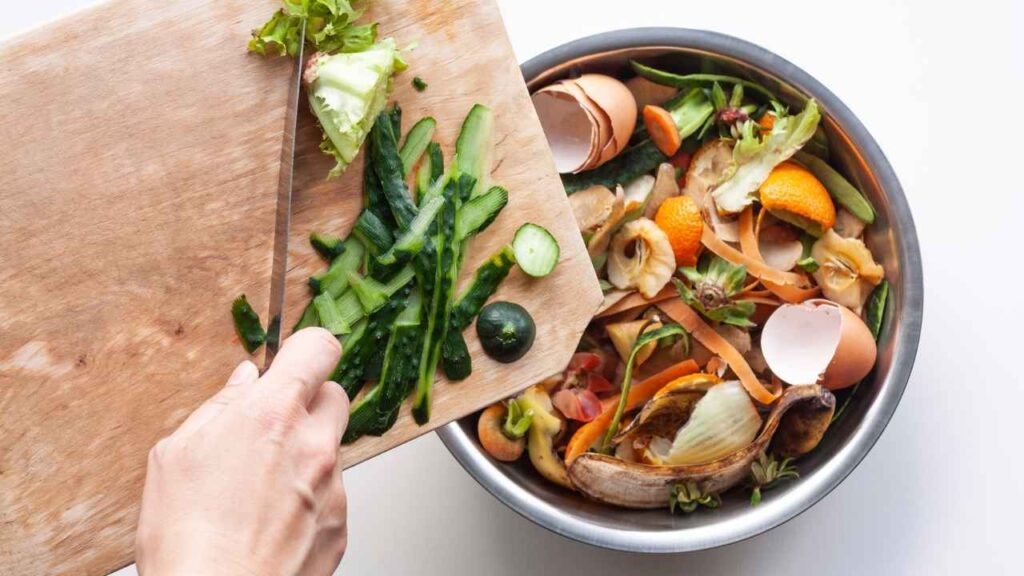
Begin by designating a compost bin in your kitchen. Collect fruit and vegetable peels, coffee grounds, tea bags, and eggshells. Avoid adding meat, dairy, and oily items to prevent unpleasant odors and attract pests.
Creating a Compost Bin:

You don’t need a fancy setup to compost. A simple DIY bin using a plastic or wooden container with a lid will suffice. Ensure good aeration by poking holes in the sides and bottom.
Layering Green and Brown Material:
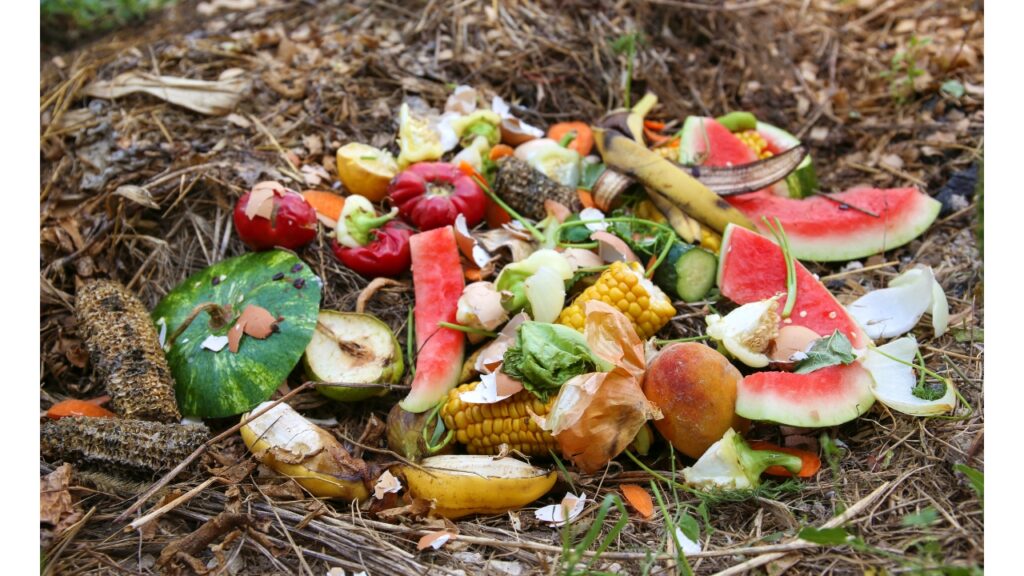
Composting works best when you balance green (nitrogen-rich) and brown (carbon-rich) materials. Greens include kitchen scraps, while browns encompass items like dry leaves, newspaper, or cardboard. Aim for a 3:1 ratio of brown to green material.
Turning the Compost:
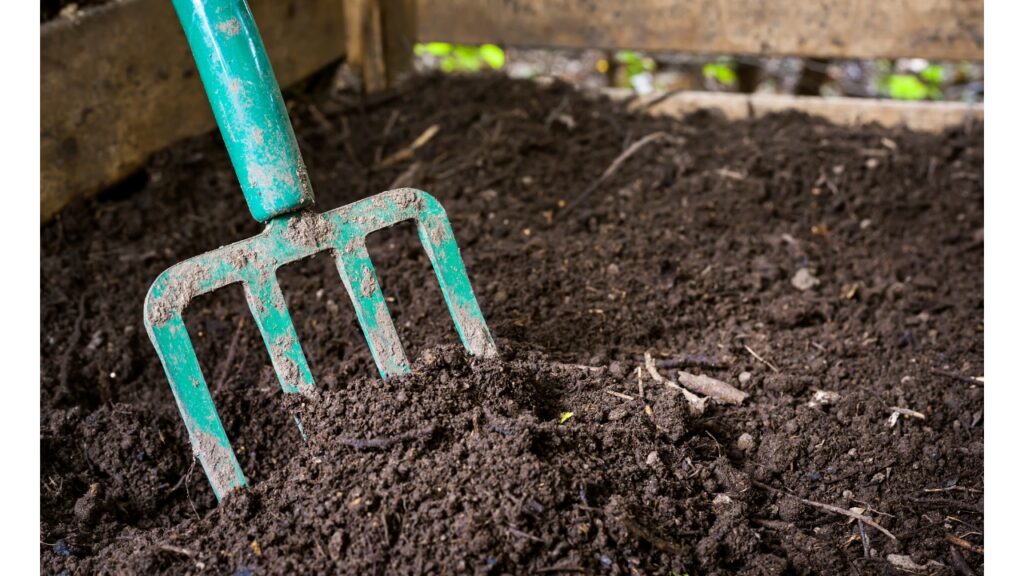
Regularly turn the compost to enhance aeration and speed up the decomposition process. This can be done with a pitchfork or simply by mixing the contents with a shovel.
Patience is Key:
Composting is a gradual process. Depending on the conditions, it may take several weeks to months for your kitchen waste to transform into nutrient-rich compost. Be patient and let nature take its course.
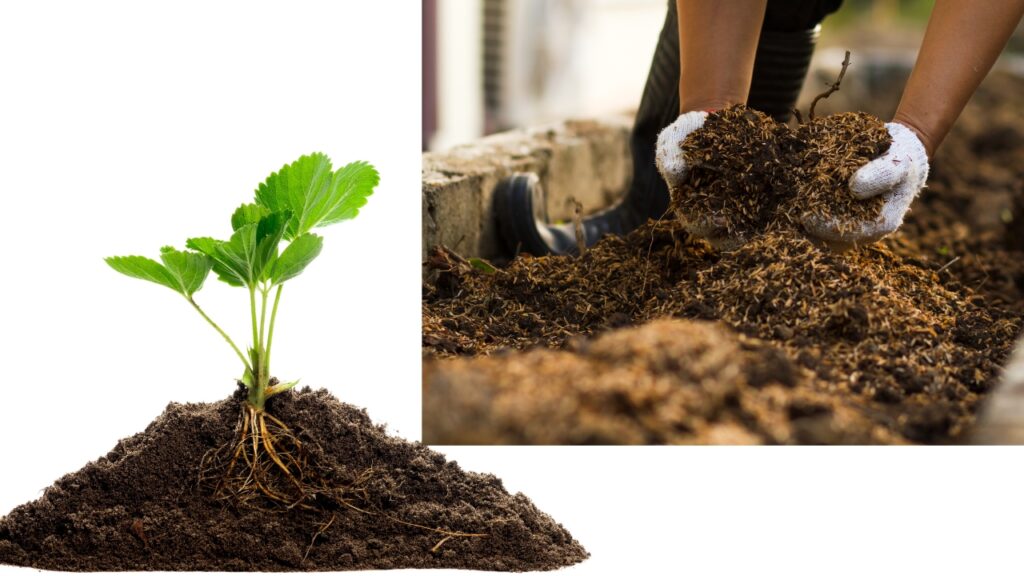
Table of Contents
What kind of kitchen refuse can be composted?
- Fruit and Vegetable Scraps:
Banana peels, apple cores, carrot tops, and other fruit and vegetable scraps are excellent additions to your compost bin. - Coffee Grounds:
Used coffee grounds are rich in nitrogen and make for a fantastic addition to your compost, enhancing its overall nutrient content. - Eggshells:
Crushed eggshells add calcium to your compost, benefiting plants by preventing blossom end rot. - Paper Towels and Napkins:
Unbleached paper towels and napkins can be added to the compost bin, providing carbon material. - Tea Bags:
Non-plastic tea bags can be included in your compost pile, contributing to the nitrogen component. - Paper Towels and Napkins:
- Unbleached paper towels and napkins, free from chemicals, can be composted.
- Cardboard:
- Shredded cardboard can be added as a source of carbon to balance the compost.
- Cooked Rice and Pasta:
- Small amounts of cooked rice and pasta are suitable for composting.
- Stale Bread:
- Stale or moldy bread can be composted, but in moderation.
- Nut Shells:
- Shells from nuts like peanuts, walnuts, and almonds can be composted.
- Herb Stems and Spices:
- Stems from herbs and small amounts of spices can be added to the compost.
- Citrus Peels:
- Citrus peels, such as from oranges and lemons, can be composted. However, use them in moderation due to their acidity.
- Corn Cobs:
- Corn cobs can be composted, but it’s advisable to break them into smaller pieces for quicker decomposition.
- Onion and Garlic Peels:
- Peels from onions and garlic can be added to the compost.
- Avocado Pits:
- Avocado pits take longer to break down, but they can be added to the compost bin.
- Moldy Cheese:
- Small amounts of moldy cheese can be composted, but avoid adding large quantities.
- Pizza Boxes:
- Clean and tear up pizza boxes for composting, removing any greasy or heavily soiled parts.
- Seeds from Fruits and Vegetables:
- Seeds from tomatoes, peppers, and other fruits and vegetables can be composted.
- Paper Egg Cartons:
- Cardboard egg cartons can be torn into pieces and added to the compost.
- Stems from Leafy Greens:
- Stems from kale, spinach, and other leafy greens can be composted.
- Cereal Boxes:
- Remove any plastic or metallic parts, then shred and compost cardboard cereal boxes.
Composting kitchen waste outside
Composting kitchen waste outside is an excellent way to reduce your environmental footprint and enrich your garden soil. There are various types of composting systems suitable for outdoor use, each with its own advantages. Here are some common types of composting for kitchen waste outdoors:
Backyard Compost Bin:
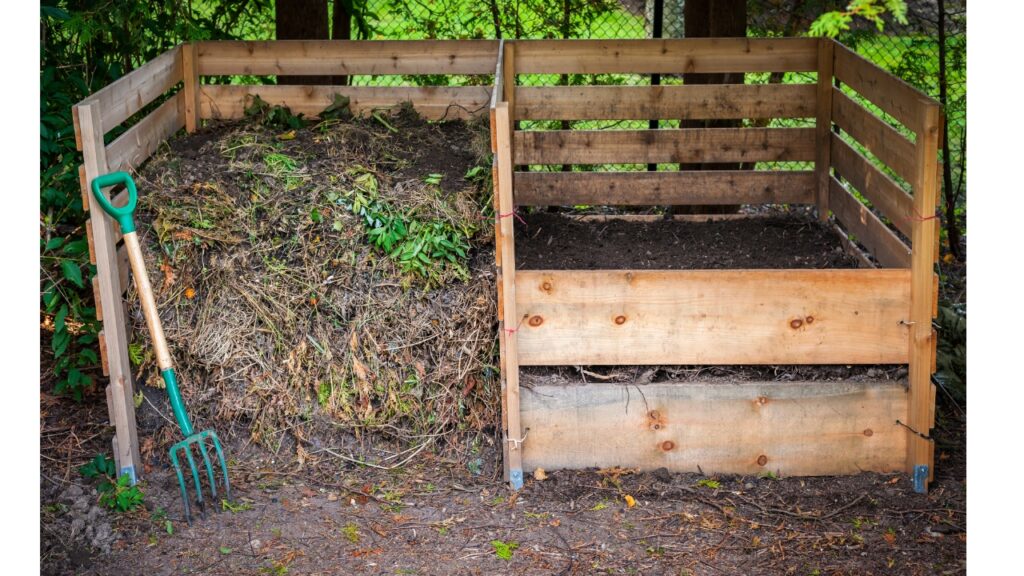
A backyard compost bin is a container placed directly on the ground in which organic kitchen waste and yard debris are composted. It’s an easy and effective way for individuals with outdoor space to recycle kitchen scraps and create nutrient-rich compost for their gardens. The process involves layering kitchen waste with brown materials like leaves or straw and regularly turning the contents to promote aeration and decomposition. Backyard compost bins are an environmentally friendly solution that allows individuals to actively participate in reducing their household waste while producing valuable compost for gardening purposes.
Tumbler Composter
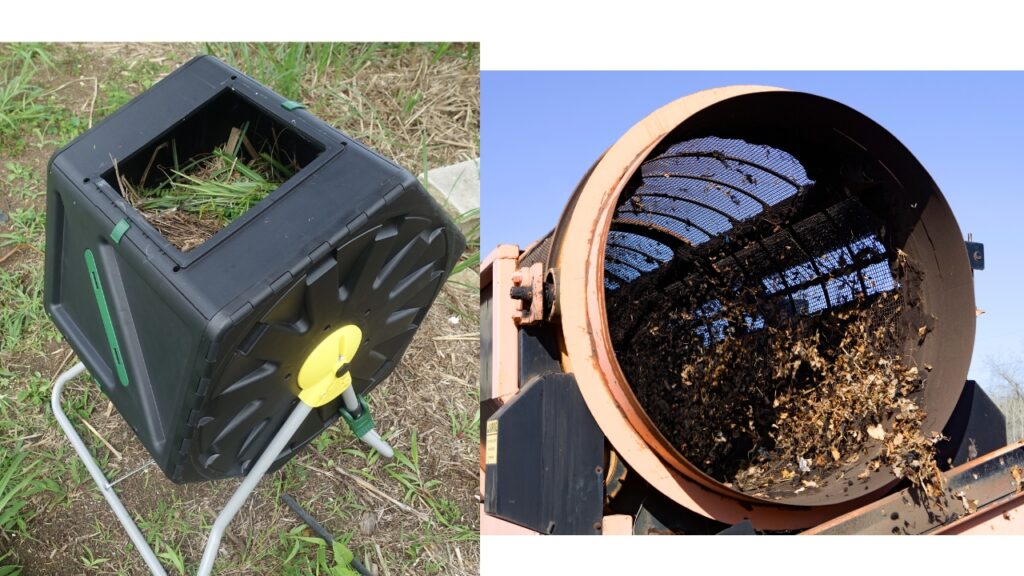
A Tumbler Composter is a cylindrical container designed for efficiently composting organic materials. It typically has a secure lid and is mounted on a base, allowing it to be rotated or tumbled. This design aids in the aeration and mixing of composting materials, promoting faster decomposition. Users can add kitchen scraps, yard waste, and other compostable materials into the tumbler. By regularly rotating the container, the composting process is accelerated, creating a well-aerated and homogeneous compost. Tumbler composters are popular for their ease of use, efficient decomposition, and reduced need for manual turning compared to traditional composting methods. They are especially suitable for individuals who want a convenient and space-saving solution for composting kitchen waste outdoors.
Pile Composting
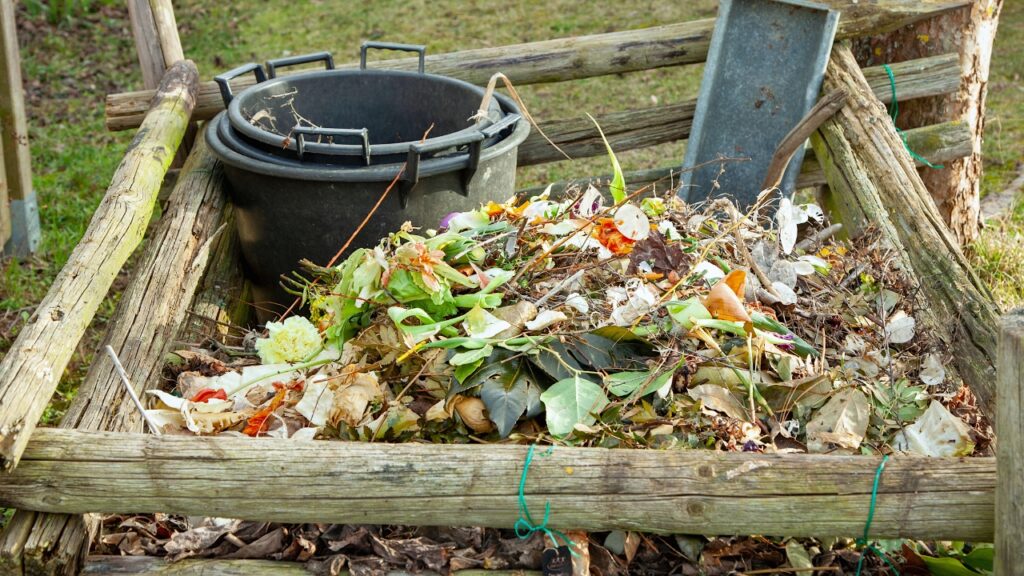
Pile composting is a simple and traditional method of composting where organic materials are stacked directly on the ground, forming a compost pile without the use of a bin or enclosure.
Ideal For: Individuals with larger outdoor spaces where aesthetics are not a primary concern.
How It Works:
- Select a Site: Choose a location in your yard or garden for the compost pile. Ensure good drainage and access to sunlight.
- Build the Pile: Alternate layers of “green” materials (nitrogen-rich) such as kitchen scraps, with “brown” materials (carbon-rich) like leaves, straw, or shredded newspaper.
- Turn the Pile: Regularly turn the compost pile with a pitchfork or shovel to aerate the materials. Turning promotes decomposition by introducing oxygen and speeding up the breakdown process.
- Maintain Moisture: Keep the compost pile moist but not waterlogged. Add water if the pile becomes too dry, and cover it during heavy rain to prevent oversaturation.
- Patience: Pile composting is a slower process compared to other methods. Be patient, and over time, the organic materials will break down into nutrient-rich compost.
Considerations:
- May not be visually appealing, so choose a location that suits your preferences.
- Regular turning is essential for optimal results.
- Larger outdoor spaces are preferable for this method.
Pile composting is a straightforward and effective way to convert kitchen waste into valuable compost for your garden, providing a sustainable solution for managing organic materials.
Vermicomposting (Outdoor Worm Bin):
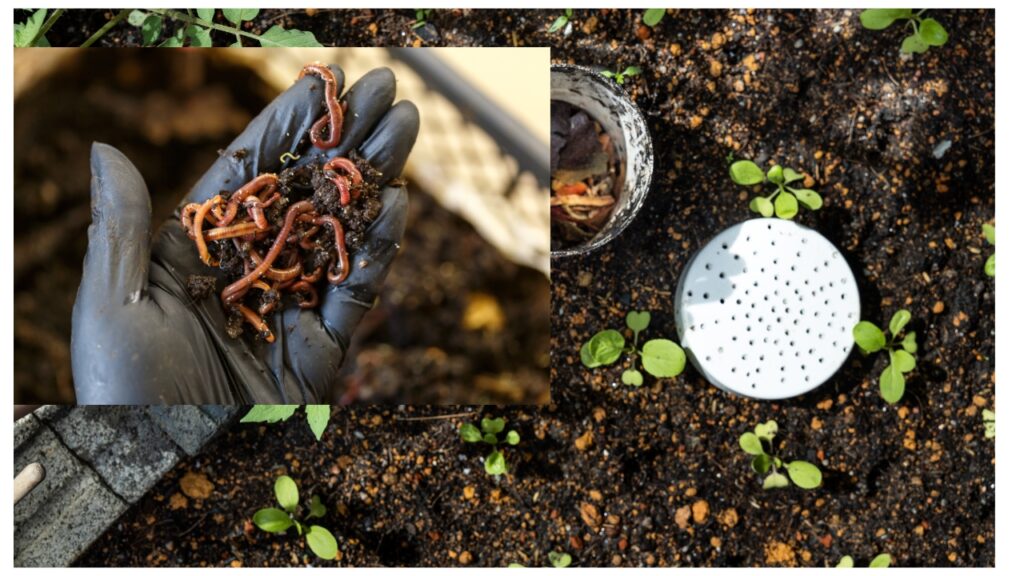
Vermicomposting is a composting method that utilizes worms to break down organic waste materials, such as kitchen scraps and garden waste, into nutrient-rich compost. In short, vermicomposting involves creating a controlled environment, typically in a bin or container, where specific species of worms, usually red worms (Eisenia fetida or Eisenia andrei), consume and digest the organic matter.
Key Steps in Vermicomposting:
- Selecting a Bin: Choose a suitable container or bin for vermicomposting. It can be a purpose-built vermicomposting bin or a repurposed container with proper aeration and drainage.
- Bedding Material: Create a comfortable environment for the worms by adding bedding materials such as shredded newspaper, cardboard, or coconut coir. This provides a carbon-rich base for the composting process.
- Adding Worms: Introduce composting worms to the bedding. Red worms are commonly used for vermicomposting due to their efficient composting abilities.
- Feeding Worms: Regularly add kitchen scraps like fruit and vegetable peels, coffee grounds, and eggshells to the vermicomposting bin. Avoid adding citrus, meat, dairy, and oily items.
- Maintaining Moisture and Aeration: Ensure the bedding remains consistently moist, but not waterlogged. Provide aeration by turning the bedding occasionally to prevent anaerobic conditions.
- Harvesting Compost: After a few months, the worms will have transformed the organic waste into nutrient-rich castings. Harvest the compost by removing the finished vermicompost and separating it from any remaining bedding.
Vermicomposting is a practical and eco-friendly way to recycle kitchen waste while producing a valuable resource for plant growth. It’s a fascinating example of nature’s recycling process harnessed for sustainable and human-friendly waste management.
Pit Composting:
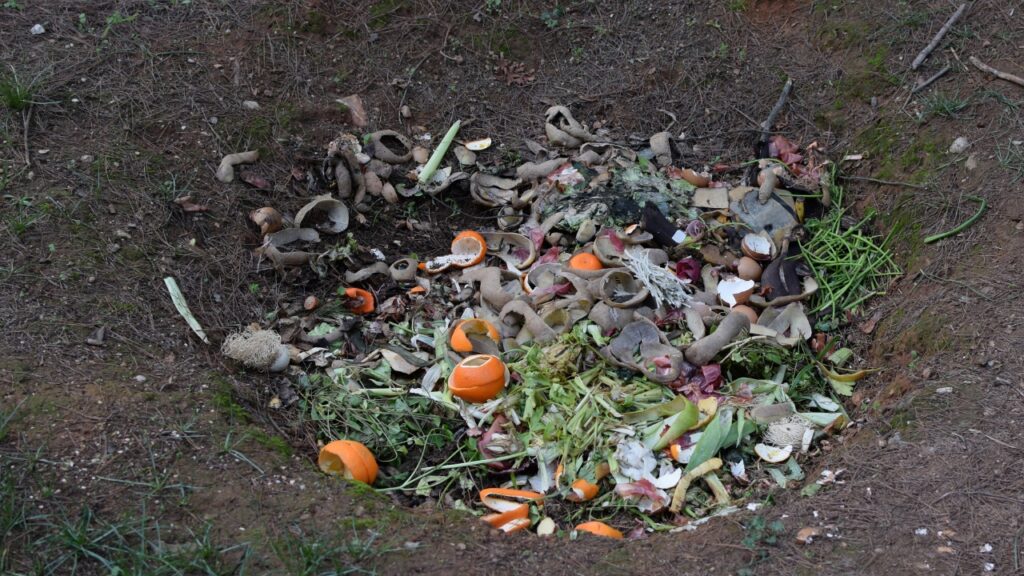
Pit composting is a simple and effective method of recycling kitchen waste directly in the ground. This technique involves digging a hole or pit in the soil, usually about one to two feet deep, where kitchen scraps are buried. The process begins by placing a layer of brown materials, such as dry leaves or shredded newspaper, at the bottom of the pit. Kitchen waste, including fruit and vegetable scraps, coffee grounds, and eggshells, is then added on top of this layer.
To optimize the composting process, it’s advisable to cover the waste with another layer of brown materials and periodically mix or turn the contents. Pit composting allows for natural aeration and drainage, promoting the decomposition of organic matter. Over time, the pit becomes a rich source of nutrient-dense compost, enhancing the fertility of the surrounding soil. This method is particularly suitable for individuals with ample outdoor space and a desire for a straightforward composting approach.
Frequently Asked Questions
Can I compost in an apartment or with limited outdoor space?
Yes, you can compost in small spaces. Consider using compact compost bins or explore indoor composting options like vermicomposting, which uses worms to break down organic waste.
How long does it take to make compost from kitchen waste?
The time required to make compost varies, but it generally takes several weeks to months. Factors such as temperature, moisture, and the balance of green and brown materials influence the speed of decomposition.
What can I do to prevent odors and pests in my compost bin?
To prevent odors and pests, maintain a balanced ratio of green to brown materials, avoid adding meat or dairy, and turn the compost regularly. Keep the compost bin covered to deter pests.
Can I compost cooked food leftovers?
While raw fruit and vegetable scraps are ideal, small amounts of cooked food leftovers can be composted. However, avoid large quantities, as they may attract pests and slow down the composting process.
Can I compost citrus peels and onions?
Yes, citrus peels and onions can be composted. However, use them in moderation, as they are acidic and may affect the pH of the compost.
Can I compost in the winter?
Yes, composting is possible in winter, but the process may slow down due to lower temperatures. Consider insulating the compost bin with straw or leaves to help maintain heat.
How can I use the compost in my garden?
Once the compost is ready, use it as a soil amendment in your garden. Spread a layer over the soil surface or mix it with existing soil to improve fertility and structure.
Is it necessary to turn the compost regularly?
Turning the compost helps aerate the pile, promoting decomposition. While not mandatory, regular turning accelerates the composting process and prevents the formation of compacted, anaerobic conditions.
What do I do if my compost is too wet or too dry?
If the compost is too wet, add more dry, brown materials like leaves or newspaper. If it’s too dry, water it gradually while turning to ensure even moisture distribution.
Can I compost in a traditional garbage bin?
Yes, you can repurpose a traditional garbage bin for composting. Ensure it has proper aeration by drilling holes in the bottom and sides. Follow the same layering and turning process for optimal results.
Can I compost pet waste?
It’s not recommended to compost pet waste in a kitchen compost bin, as it may contain harmful pathogens. Consider specialized composting systems for pet waste or explore alternatives like flushing it down the toilet in small quantities.
How can I troubleshoot common composting problems?
Common composting problems, such as bad odors or slow decomposition, can be addressed by adjusting the green-to-brown ratio, turning the compost more frequently, and ensuring proper aeration.
You should remember, successful kitchen composting involves experimentation and adaptation based on your unique circumstances and the specific conditions of your composting setup.
Statistics on the Impact of Composting
- According to the Environmental Protection Agency (EPA), food scraps and yard waste together constitute more than 28% of what we throw away.
- The EPA also estimates that composting can prevent almost 30% of household waste from ending up in landfills.
- A study published in the journal ‘Waste Management’ found that composting organic waste reduces greenhouse gas emissions, contributing to climate change mitigation.
Challenges in Composting
- Odor and Pests:
Inadequate balance of green and brown material can lead to unpleasant odors and attract pests. Proper layering and turning can help mitigate this challenge. - Space Limitations:
Individuals living in apartments or with limited outdoor space may face challenges in setting up and maintaining a compost pile. However, compact compost bins or indoor composting options can be explored. - Time and Patience:
Composting is a slow process that requires patience. Some individuals may find it challenging to wait for the compost to be ready for use.
Conclusion
“In conclusion, making compost from kitchen waste is not only an eco-friendly endeavor but also a deeply human one. By embracing this sustainable lifestyle, you contribute to a healthier planet while experiencing a profound sense of connection to nature. The challenges are surmountable, and the emotional rewards are immeasurable. As we navigate the complexities of modern living, composting provides a tangible way to make a positive impact and leave a lasting legacy for generations to come. If you’re seeking more inspiration and sustainable living tips, platforms like WeCareEarth offer valuable resources to further enhance your journey toward a greener, more eco-conscious lifestyle.”
In-depth guides on composting are available online, and one comprehensive resource is ‘Help Me Compost.’ Their article on how to make compost from kitchen waste provides valuable insights and practical steps for implementing a successful composting routine. For more detailed information, you can refer to their guide here: How to Make Compost from Kitchen Waste.”
